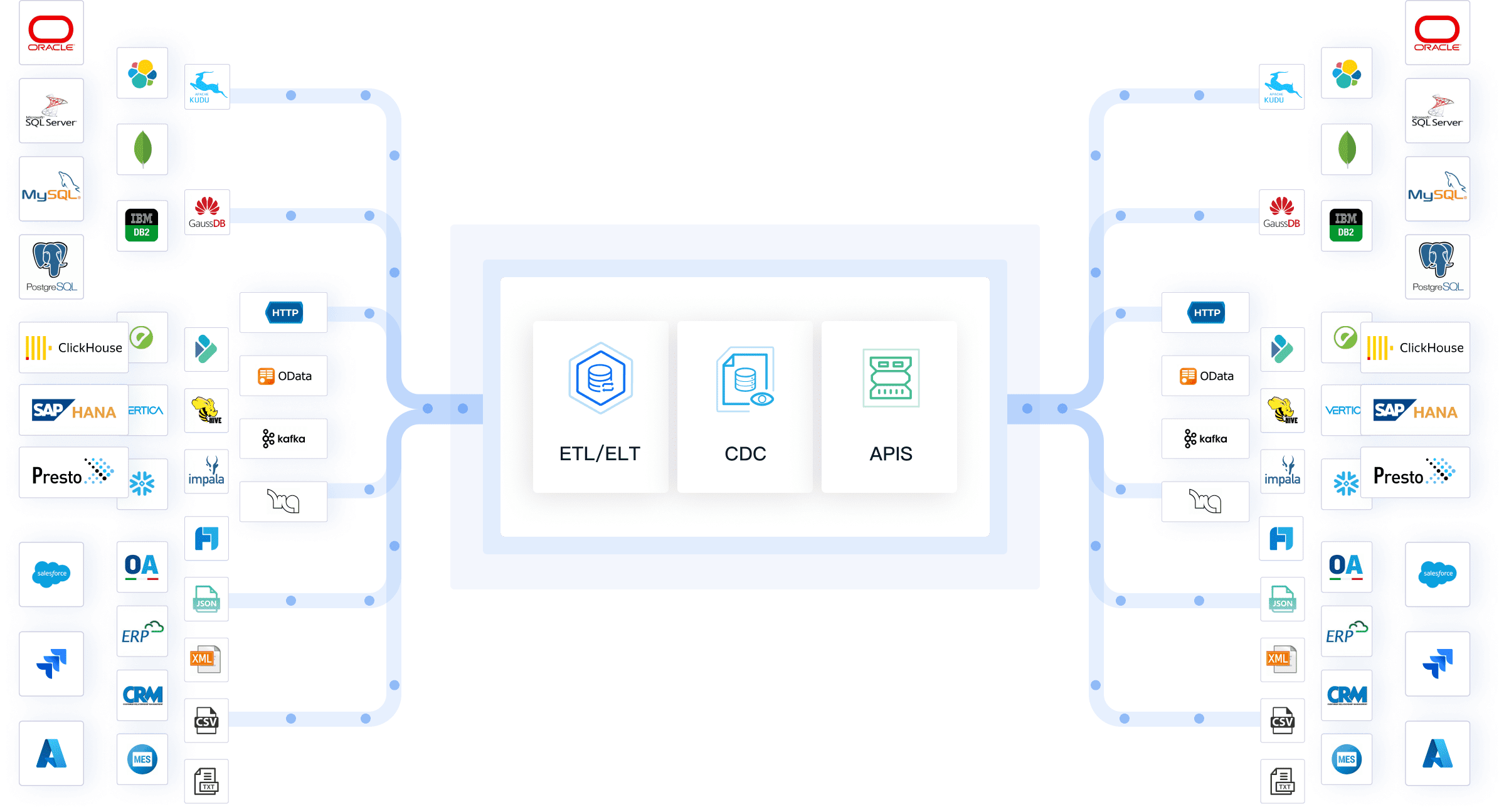A data warehouse requirements checklist helps you identify everything needed for a successful data warehouse project. You use this checklist to make sure you address all important factors, such as system architecture, integration between platforms, security features, and performance goals. This structured approach prevents missed steps and reduces risk. Tools like FineDataLink support your efforts by simplifying integration and data management.
Data Warehouse Requirements Overview

What is a Data Warehouse
A data warehouse is a centralized system that stores and manages large volumes of data from different sources. You use a data warehouse to collect, organize, and analyze information for business intelligence and reporting. This system helps you bring together data from transactional databases, social media, and other platforms. The main goal is to create a single source of truth for your organization.
You will find several types of data warehouse solutions available today. Each type serves a specific purpose and fits different business needs. The table below shows the most common types of data warehouse systems and their descriptions:
| Type of Data Warehouse | Description |
|---|---|
| Enterprise Data Warehouse (EDW) | Integrates data from various business areas for a unified view. |
| Operational Data Store (ODS) | Holds data from operational systems for near real-time reporting. |
| Data Mart | Focuses on a specific department or user group. |
| Cloud Data Warehouse | Offers scalable storage and analysis in the cloud. |
| Big Data Warehouse | Handles large volumes of structured and unstructured data. |
| Virtual Data Warehouse | Provides a logical view of data without physical storage. |
| Hybrid Data Warehouse | Combines on-premises and cloud storage for flexibility. |
| Real-time Data Warehouse | Processes and analyzes data as it is generated for immediate insights. |
A modern data warehouse includes several key components. You will see data sources, data ingestion processes, storage, processing engines, metadata management, and real-time integration. These elements work together to ensure your data warehouse delivers accurate and timely information.
Key Benefits
When you implement a data warehouse, you unlock many advantages for your organization. You gain the ability to integrate data from multiple sources, which ensures consistency and reliability. Your data warehouse keeps historical records, making it easy to analyze trends over time. You can perform advanced analytics and complex queries to support strategic decisions.
A data warehouse also improves performance by optimizing queries on large datasets. You separate analytical workloads from operational systems, which reduces the impact on daily business activities. Many organizations report measurable benefits after deploying a data warehouse. For example, Helsana, a Swiss health insurer, reduced license and maintenance costs by 65% in the first year and achieved query speeds five to ten times faster than before.
You will also benefit from features like real-time data integration, data quality management, and support for business intelligence tools. These features help you make informed decisions, respond quickly to changes, and maintain a competitive edge.

Data Warehouse Requirements
Architecture
When you start building your data warehouse, you need to focus on the architecture. The data warehouse requirements checklist should begin with a review of your current data infrastructure and future needs. A well-designed data warehouse architecture includes components for efficient storage, processing, and analysis. You must decide if you want a centralized system or one that allows flexibility for different departments. Your architecture should support your business goals and analytical needs.
Key checklist items for architecture:
- Assess your current data infrastructure.
- Choose between centralized and decentralized models.
- Ensure compatibility with existing systems.
- Plan for future scalability and integration.
- Tailor the architecture to your organization’s analytical needs.
Scalability
Scalability is a critical part of any data warehouse requirements checklist. Your data warehouse must grow with your business. You should design systems that expand without major overhauls. Modular and API-driven architectures make updates and integration easier. Real-time processing helps you get insights quickly. Automation and clear documentation reduce errors and save time. Always prioritize compliance with privacy laws.
"Scalability means having the ability to increase revenue without a proportional increase in costs." - Jen Stamulis
| Aspect | Cloud data warehouses | On-premises data warehouses | Hybrid data warehouses |
|---|---|---|---|
| Cost scalability | Scales immediately | Manual and costly scaling | Flexible with cloud |
| Best for | Fast-growing, flexible needs | Compliance, legacy systems | Specialized, transitional |
Checklist for scalability:
- Build for growth without costly changes.
- Use modular, API-driven designs.
- Enable real-time data processing.
- Automate repetitive tasks.
- Document processes clearly.
- Ensure compliance with regulations.
Data Integration
Data integration is at the heart of the data warehouse requirements checklist. You need to bring together data from many sources, which can be complex. Set clear goals for integration. Consider the volume and speed of data you need to process. Evaluate the complexity of your data formats. Identify all your data sources. Choose integration tools that automate and maintain the process. Start extracting, cleaning, and transforming your data. Load it into your central repository. Establish strong data governance practices. Monitor and maintain your integration regularly.
Checklist for data integration:
- Define your integration goals.
- Assess data volume and speed.
- Evaluate data complexity and formats.
- Identify all data sources.
- Select the right integration tools.
- Extract data from sources.
- Clean and transform data.
- Load data into the warehouse.
- Set up data governance.
- Monitor and maintain integration.
You can see the impact of strong integration in real-world cases. For example, DAS Corporation improved its global operations by automating data integration and building an enterprise data warehouse. This led to real-time access, better accuracy, and more efficient management.

Data Quality
Data quality is essential for reliable analytics. Your data warehouse requirements checklist should include steps to ensure high data quality. You need to measure integrity, bias, conciseness, relevance, reliability, timeliness, usability, completeness, consistency, privacy, security, and freshness. Poor data quality, such as duplicates or inaccuracies, can lead to bad decisions and wasted resources.
| Metric Type | Description |
|---|---|
| Integrity | Accuracy, consistency, completeness |
| Bias | Accuracy related to skewed outcomes |
| Conciseness | Amount of redundant data |
| Relevance | Meets stakeholder needs |
| Reliability | Data is true and credible |
| Timeliness | Data is up-to-date |
| Usability | Data is easy to access and understand |
| Completeness | Data describes the real world fully |
| Consistency | Data is internally consistent |
| Privacy and Security | Data meets privacy and security requirements |
| Freshness | Data reflects the current moment |
Checklist for data quality:
- Regularly profile and clean your data.
- Remove duplicates and correct inaccuracies.
- Ensure data is relevant and timely.
- Maintain clear documentation.
- Monitor for data downtime.
Security
Security is a top priority in any data warehouse requirements checklist. You must protect sensitive information and comply with regulations. Common standards include ISO 27001, GDPR, HIPAA, CCPA, SOX, and PCI DSS. You need to guard against threats like SQL injection, information leakage, and unauthorized access. Use strong input validation, parameterized queries, and regular security audits. Limit access to sensitive data and use encryption for data transmission.
| Regulation | Description |
|---|---|
| ISO 27001 | International standard for information security management |
| GDPR | Strict controls over personal data |
| HIPAA | High standards for health data protection |
| CCPA | Control over personal information for California residents |
| SOX | Data integrity and security for financial records |
| PCI DSS | Secure networks and access controls for credit card data |
Checklist for security:
- Implement strict input validation.
- Use parameterized queries.
- Encrypt sensitive data.
- Limit and log access to data.
- Conduct regular security audits.
- Ensure compliance with all relevant regulations.
Performance
Performance affects how well your data warehouse supports business intelligence. The data warehouse requirements checklist should include benchmarks like TPC-DS, which tests large datasets and complex queries. Fast query response times improve user experience and decision-making. Optimized queries reduce server load and resource use.
Checklist for performance:
- Use industry-standard benchmarks for evaluation.
- Optimize schema design for performance.
- Monitor and tune query response times.
- Separate analytical workloads from operational systems.
- Regularly review and improve performance.
"A well-optimized data warehouse is not just a nice-to-have, but a business imperative." - Ralph Kimball and Ross
Accessibility
Accessibility ensures everyone in your organization can use the data warehouse. Your data warehouse requirements checklist should include self-service BI tools, user-friendly interfaces, and support for data literacy. These features help non-technical users interact with data and make informed decisions. High data literacy rates lead to better engagement and collaboration.
Checklist for accessibility:
- Provide self-service BI tools.
- Use intuitive, user-friendly interfaces.
- Offer training to improve data literacy.
- Design for accessibility from the start.
- Balance security with accessibility by defining clear roles and permissions.
The balance between security and accessibility is vital. The most secure systems can be hard to access, so you need to implement strong security while keeping the system usable.
Cost
Cost is a major factor in your data warehouse requirements checklist. You need to consider storage, ETL and data integration, and business intelligence tools. Cloud data warehouse solutions often have lower initial costs than on-premises systems. On-premises solutions may require large upfront investments and ongoing maintenance.
| Solution Type | First-Year Cost | Annual Cost After First Year |
|---|---|---|
| Cloud | $15k-$20k | N/A |
| On-Premises | $160k+ | $50k-$100k |
Checklist for cost:
- Calculate storage costs for your chosen solution.
- Estimate ETL and data integration expenses.
- Factor in BI and analytics tool costs.
- Compare cloud and on-premises total cost of ownership.
- Plan for future scaling and maintenance.
When you follow a comprehensive data warehouse requirements checklist, you set your project up for success. After you address all these areas, you can look for solutions that make integration and management easier. FineDataLink offers a modern platform for data integration, real-time synchronization, and ETL/ELT. It helps you build a high-quality data layer for business intelligence and supports your data management process. FineDataLink can connect over 100 data sources, automate workflows, and provide real-time data for analytics. Companies like DAS have used these tools to streamline operations and improve decision-making across global branches.

Data Warehouse Requirements: Using the Checklist

How to Apply
You can use a data warehouse requirements checklist to guide your project from planning to implementation. Start by aligning each checklist item with your project goals. Define your key data requirements early. This helps you match the data you collect with your business objectives. Cross-reference your data with project deliverables to spot missing information before it becomes a problem.
The following table outlines practical steps for applying a data warehouse requirements checklist in real projects:
| Step | Description |
|---|---|
| 1 | Align checklist items with project goals through careful planning. |
| 2 | Define key data requirements early to match project aims. |
| 3 | Cross-reference data with deliverables to identify gaps. |
| 4 | Create a data flow diagram to visualize processes and issues. |
| 5 | Set up ongoing data validation with automated and manual checks. |
| 6 | Research industry-specific needs to customize your checklist. |
| 7 | Identify data sources and define clear project requirements. |
You should also set up feedback loops with users to keep your checklist updated. Regular training for your team on data standards and changes will help maintain quality. Always keep data validation as an ongoing process, not a one-time task.
Common Pitfalls
Many organizations face similar challenges when using a data warehouse requirements checklist. The most common mistakes include:
- Starting without clear business objectives.
- Failing to manage data quality from the beginning.
- Underestimating the complexity of data integration.
- Designing systems that cannot scale with future growth.
- Excluding key stakeholders from the process.
- Skipping thorough testing and validation.
- Ignoring security and compliance requirements.
You can avoid these pitfalls by introducing quality assurance early and profiling your source data before integration. Always assess your current data warehouse situation before making changes. Design your integration for elasticity so it can handle both real-time and batch processing. This approach helps you avoid operational issues and missed opportunities.
If you need help tailoring your checklist or managing integration complexity, consider consulting with vendors like FineDataLink. They offer solutions for real-time data integration, ETL/ELT, and data synchronization, which can streamline your project and reduce risk.

Meeting every data warehouse requirement leads to successful implementation and long-term value. A comprehensive data warehouse checklist helps you set clear objectives, engage stakeholders, and plan each step. You gain these benefits:
- Clear objectives and stakeholder engagement
- Detailed planning for better outcomes
- Alignment with business goals
After completing your data warehouse checklist, continue with ongoing monitoring, empower users with analytics tools, and ensure regular backup procedures. Consulting with FineDataLink can improve data warehouse integration by providing centralized management, improved data quality, and strategic planning.
| Benefit | Description |
|---|---|
| Improved Data Quality | Accurate, reliable data for better decisions |
| Centralized Management | Easier access and integration across systems |
| Strategic Planning | Aligns data strategy with business goals |

Continue Reading About Data Warehouse Requirements
Enterprise Data Integration: A Comprehensive Guide
What is enterprise data and why does it matter for organizations
Understanding Enterprise Data Centers in 2025
Enterprise Data Analytics Explained for Modern Businesses
FAQ

The Author
Howard
Engineer Data Management & Ahli Data Research Di FanRuan
Related Articles

Best Data Lake Vendors For Enterprise Needs
Compare top data lake vendors for enterprise needs. See which platforms offer the best scalability, integration, and security for your business.
Howard
Dec 07, 2025

Top Data Ingestion Platform Compared
Compare the top 7 data ingestion platforms, including real-time features, integration, scalability, and pricing to find the best fit for your business.
Howard
Dec 04, 2025

Best Data Lake Companies For Enterprise Needs
Compare top data lake companies for enterprise needs. See which platforms excel in scalability, integration, security, and analytics for businesses.
Howard
Dec 04, 2025



